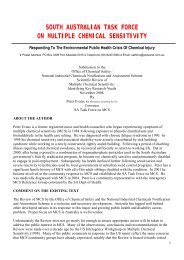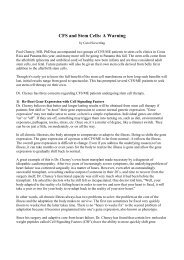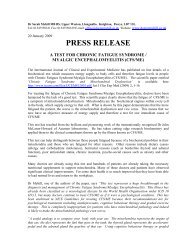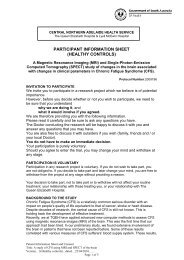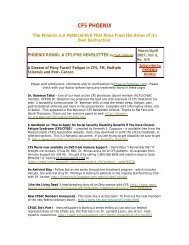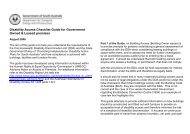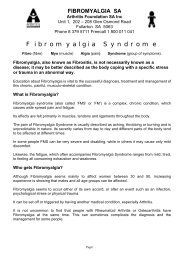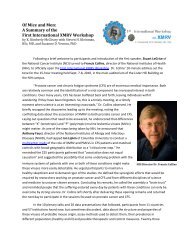26 S. Stisi et al.sensitization,” “neuroendocrine abnormalities” and“nervous autonomic amplification.” (Fig. 1).The “triggers”Fibromyalgia is often triggered by negative environmentalinfluences, especially if they occur inchildhood. In a fetus, these environmental triggersmay influence the development of the autonomicnervous system (ANS) and the hypothalamic-pituitary-adrenalaxis (HPA), which represent the keycomponents of the neuroendocrine response tostressors. Their functional alteration constitutes themain factor that predisposes individuals to developmany stress-related diseases in adulthood, includingFMS (3).Low birth weight also correlates with hyperactivityof the HPA in males and sympathetic hypertonein females; therefore, it seems that these individualshave a more intense cardiovascular response tostressors (4). A history of childhood adversity, violenceor stressors may cause a higher incidence ofcertain co-morbid conditions in adult patients withFMS such as major depression (5, 6).Likely the reaction to the stress induced by thesetraumatic events, which occurs in a critical periodfor the development of specific synapses, inducesalterations in the central nervous system (7).Although a direct causal relationship between infectiousdiseases and FMS has not been demonstrated,it seems reasonable, however, that infectionscan, in some way, act as triggering agents.The onset of FMS, in fact, has been allied withmultiple vaccinations for infectious diseases, virusesor bacteria (8). It is possible that the hypotheticalinfectious, natural or attenuated agent acts byindirectly stimulating production of cytokines thattake part in the multiple physiological functionsthat are altered in patients with FMS.Evidence supports a high prevalence of FMSamong patients with numerous chronic infections,including Epstein Barr virus, herpes 6-virus, HIVand, recently, HTLV-I virus (9, 10).Sleep disturbance could trigger mechanisms ofFMS. Moldofsky (11), in fact, artificially reproducedfibromyalgia-like symptomatology inhealthy volunteers by using an acoustic stimulus ofan intensity that was insufficient to provoke awakeningyet was able to disturb non-REM sleep. However,just as altering sleep physiology can inducethe appearance of musculoskeletal pain, the inverseis also true: nociceptive muscular stimulation appliedto healthy volunteers during sleep can alterEEG patterns (12).The risk of developing FMS seems to be increasedin patients with chronic painful conditions of anothernature; more than 80% of patients, in fact, reportthat they have suffered from a chronic localizedpainful condition before the generalization ofpain (13). In patients affected by symptomatic hiposteoarthritis abnormalities of the inhibitory systemfor nociception, similar to that documented in FMSpatients, have been found; these abnormalities normalizefollowing successful prosthetic treatmentof the hip (14). Nociceptive persistent inputs aresufficiently intense; therefore, they could inducethe generalization of pain and insurgence of FMSin predisposed subjects.A particular sensitivity to multiple chemical substanceswould be the cause of multiple chemicalsensitivity syndrome, a dysfunctional syndromethat is closely associated with FMS and chronicfatigue syndrome. Mercury, nickel, and silicone,which is commonly used in surgical breast implants,are substances that are frequently cited aspossible causes of dysfunctional syndromes, suchas FMS (15, 16).Of particular importance as triggers of FMS arepsychological conditions that can lead to catastrophizingof pain (17, 18) or life events and, therefore,cause additional stress. There is increasingevidence supporting the comorbidity of FMS andpsychological conditions. These conditions includedepression, panic disorders, anxiety, and post-traumaticstress disorder (PTSD). The nature of the relationshipbetween depression and FMS is not fullyunderstood. Depression is a common denominatoramong chronic painful conditions (15); it hasbeen hypothesized that chronic pain causes depression,or vice versa, and that chronic pain syndromesare variants of depression. A link betweenPTSD symptoms and FMS has been reported, andboth conditions share similar symptomatology andpathogenetic mechanisms (19).The preexistence of chronic stressful conditionsprior to the onset of FMS is frequently demonstrated.The symptomatology that is reported by fibromyalgiapatients seems to be influenced negativelyby chronic stressful situations, while positivecorrelations with acute stressful events have notbeen found (20). In addition, FMS patients showhigher levels of stress compared to controls (21).GeneticsRecent evidence suggests that genetic factors mayplay a role in the pathogenesis of FMS (22-24).Certain environmental factors (“stressors”) may
Etiopathogenetic mechanisms of Fibromyalgia Syndrome 27trigger the development of FMS in genetically predisposedindividuals (25).A number of studies published over recent yearshave documented increased incidence of FMSamong family members of patients suffering fromthis syndrome (26-28).Buskila et al. found that 28% of offspring of FMSpatients fulfill the American College of Rheumatology(1990) classification criteria for the diagnosisof FMS (26). Buskila et al. reported anotherstudy, we reported that the prevalence of FMSamong blood relatives of patients with FMS was26%, and that FMS prevalence in male and femalerelatives was 14% and 41%, respectively (27).Arnold and colleagues (28) tested the hypothesesthat FMS and measures of pain and tenderness aggregatein families and that FMS co-aggregateswith major mood disorder. They performed a familyinterview study of 78 probands with FMS and40 probands with rheumatoid arthritis (RA). Theyassessed FMS and major mood disorder in a totalof 533 first degree relatives of FMS probands anda total of 272 first degree relatives of RA probands.FMS was found to aggregate strongly in families: theodds ratio measuring the odds of FMS in a relativeof a proband with FMS versus the odds of FMS inrelative of a proband with RA was 8.5. The clear familialaggregation in FMS and related conditionsmay represent either genetic or environmental influence,or most likely a combination of both.Based on the strong evidence of a familial aggregationin FMS, a considerable amount of researchhas been conducted in search of the genetic underpinningsof this phenomenon. At present no evidencehas emerged to suggest a monogenic modeof transmission, and a multifactorial mode of transmissionis generally presumed.Research done in recent years has demonstrated arole for polymorphisms of genes in the serotonergic,dopaminergic and catecholaminergic systemsin the etiology of FMS.Offenbaecher and colleagues (29) analyzed thegenotypes of the promoter region of the serotonintransporter gene (5-HTT) in 62 patients with FMSand 110 healthy controls. A significantly higherfrequency of the S/S genotype of the serotonintransporter promoter region was found in FMS patients(31%) compared with healthy controls(16%). The S/S subgroup exhibited higher meanlevels of depression and psychological distress. Itwas suggested that the results support the notion ofaltered serotonin metabolism in at least a subgroupof patients with FMS.In another study, these researches reported on asignificantly different genotype distribution in FMSpatients with a decrease in T/T and an increase inboth T/C and C/C genotypes compared to the controlpopulation (30).Cohen and colleagues (31) performed genotypingin a group of 99 female FMS patients from two Israeliethnic groups. Additionally, each patient wasassessed with the Tridimensional Personality Questionnaire(TPQ). The results of this study confirmthe association between FMS and the serotonintransporter promoter region (5 - HTTLPR) polymorphismin two ethnic groups in Israel, Jewishand Bedouins. A significant association between 5- HTTLPR polymorphism and anxiety-related personalitytraits was found as well (31).Zubieta and colleagues (32) examined the influenceof a common functional genetic polymorphismaffecting the metabolism of catecholamineson the modulation of responses to sustained painin humans. Individuals homozygous for the Met158 allele of the catechol - O methyltransferase(COMT) polymorphism (Val 158 Met) show diminishedregional mu-opioid system responses topain compared with heterozygotes. These effectswere accompanied by higher sensory and affectiveratings of pain and a more negative internal affectivestate.It was concluded that the COMT Val 158 Met polymorphisminfluences the human experience of painand may underlie interindividual differences in theadaptation and responses to pain and other stressfulstimuli (32).Gursory and colleagues (33) have reported on theinvolvement of COMT gene polymorphism in patientswith FMS. Recently, Vargas-Alarcon et al.(35) reported that in a group of Spanish patients,there was an association between FMS and theCOMT haplotype. However, this association wasnot observed in Mexican patients.Buskila and colleagues (35) reported a significantdecrease in the frequency of the 7 repeat allele inexon III of the DR receptor gene in FMS patientsand also demonstrated an association between thepolymorphism and the low novelty seeking personalitytrait. Altogether, recent evidence suggestsa role for polymorphism of genes in the serotonergic,dopaminergic and catecholaminergic systemsin the etiopathogenesis of FMS.Thus recent evidence suggests a role for geneticand familial factors in the development of FMS.The mode of inheritance in FMS is unknown, butit is most probably polygenic. Recognition of these
- Page 2 and 3: 2 P. Sarzi-Puttini et al.The meetin
- Page 4 and 5: 4 M. Cazzola et al.(2). In the earl
- Page 6 and 7: 6 M. Cazzola et al.enough to meet F
- Page 8 and 9: 8 M. Cazzola et al.Table I - Charac
- Page 10 and 11: 10 M. Cazzola et al.Table IV - Cond
- Page 12 and 13: 12 M. Cazzola et al.teria, three su
- Page 14 and 15: 14 M. Cazzola et al.tients with a n
- Page 16 and 17: 16 G. Cassisi et al.The cardinal fe
- Page 18 and 19: 18 G. Cassisi et al.StiffnessIn FM
- Page 20 and 21: 20 G. Cassisi et al.Autonomic and n
- Page 22 and 23: 22 G. Cassisi et al.Associated symp
- Page 24 and 25: 24 G. Cassisi et al.46. Coleman RM,
- Page 28 and 29: 28 S. Stisi et al.Sum oflife-events
- Page 30 and 31: 30 S. Stisi et al.trols, they prese
- Page 32 and 33: 32 S. Stisi et al.stress, obtained,
- Page 34 and 35: 34 S. Stisi et al.50. Harris RE, Cl
- Page 36 and 37: ORIGINAL ARTICLEReumatismo, 2008; 6
- Page 38 and 39: 38 F. Atzeni et al.lalanine (17), a
- Page 40 and 41: 40 F. Atzeni et al.clearer and it m
- Page 42 and 43: 42 F. Atzeni et al.healthy control
- Page 44 and 45: 44 F. Atzeni et al.and/or verbal (e
- Page 46 and 47: 46 F. Atzeni et al.for study purpos
- Page 48 and 49: 48 F. Atzeni et al.mimics of fibrom
- Page 50 and 51: ORIGINAL ARTICLEReumatismo, 2008; 6
- Page 52 and 53: 52 P. Sarzi-Puttini et al.A larger
- Page 54 and 55: 54 P. Sarzi-Puttini et al.from 1966
- Page 56 and 57: 56 P. Sarzi-Puttini et al.rational,
- Page 58 and 59: 58 P. Sarzi-Puttini et al.49. Toffe
- Page 60 and 61: 60 R. Casale et al.cal exercise and
- Page 62 and 63: 62 R. Casale et al.definition of
- Page 64 and 65: 64 R. Casale et al.are more or less
- Page 66 and 67: 66 R. Casale et al.trol associated
- Page 68 and 69: 68 R. Casale et al.32. Lewit K. The
- Page 70 and 71: ORIGINAL ARTICLEReumatismo, 2008; 6
- Page 72 and 73: 72 L. Altomonte et al.In a clinical
- Page 74 and 75: 74 L. Altomonte et al.Table II - We
- Page 76 and 77:
76 L. Altomonte et al.treatments de



